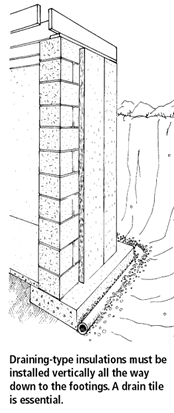Exterior basement wall insulation
Basement foundation walls can be insulated on the interior or on exterior. Outside wall insulation is common in new construction and when the foundation walls have to be repaired and waterproofed.
If you need to install a drainage system around your house, and to repair, seal and waterproof the exterior of the foundation, you may consider to insulate the outside of the basement walls, instead of their inside (see: Basement Inside Wall Insulation). Since these tasks can be done at the same time, outside insulation becomes easier and less expensive.
Recall the role of wall basement insulation: to prevent condensation problems in the basement walls (by keeping them warmer) and to reduce heat loss (in cold weather, in heated basements) and unwanted heat gains (in hot climates)
Materials & Procedures
If your basement walls are flat concrete you may use rigid polystyrene foam (extruded polystyrene/XLS or expanded polystyrene/EPS), close cell spray polyurethane or mineral wool to insulate the exterior of the walls. Do not use fiberglass.
Also avoid polyiso insulation and other water sensitive materials.
Consider insulation levels around...
- R-15/R-20 (Metric: U-0.37 - U-0.28) in colder climates;
-
at least R-5 in hot climates and...
- R-10 (Metric: U-0.57) in moderate or mixed climates (rigid expanded polystyrene or mineral wool: 2.5 inches/7 cm).
The insulation should be installed after the wall has been protected with a waterproofing or a dampproofing material.
In most cases, below-grade insulation does not need to be attached to the wall - just held in place by gravel, crushed stone of other backfill material; above-grade insulation may need to be attached to the concrete with a foam-compatible adhesive or other suitable method.
Exterior basement wall insulation in existing homes it typically part of a larger project that includes digging a trench around the foundations, wall waterproofing and a drainage system.
Partial-Depth waterproofing and insulation
If you live in a moderate or hot climate, with low levels of rain and groundwater, and if you aren't having moisture problems in your basement, you may consider a partial-depth waterproofing and insulation.
It will prevent heat transfer and condensation problems in the upper parts of the basement walls, where heat transmission is higher and condensation more likely to happen.
Consider insulating at least the first 1 feet/30 cm of the underground wall.
 Full-depth waterproofing and insulation
Full-depth waterproofing and insulation
If you are having structural problems in your basement walls or if you live in a cold, rainy climate, the partial-depth method will not be suitable. Consider in this case the full-depth method.
This method involves digging a full-depth trench around the foundation walls, sealing and damp-proofing the walls, installing foam insulation and a protective covering, and backfilling the excavated area. For technical details see this PDF: OEE Basement insulation methods.
See:
Basement Inside Wall Insulation
Moisture Management Guide
Moisture in Walls
Moisture in Attics
![]() Related Content
Related Content
![]() Top .... Home Page
Top .... Home Page


